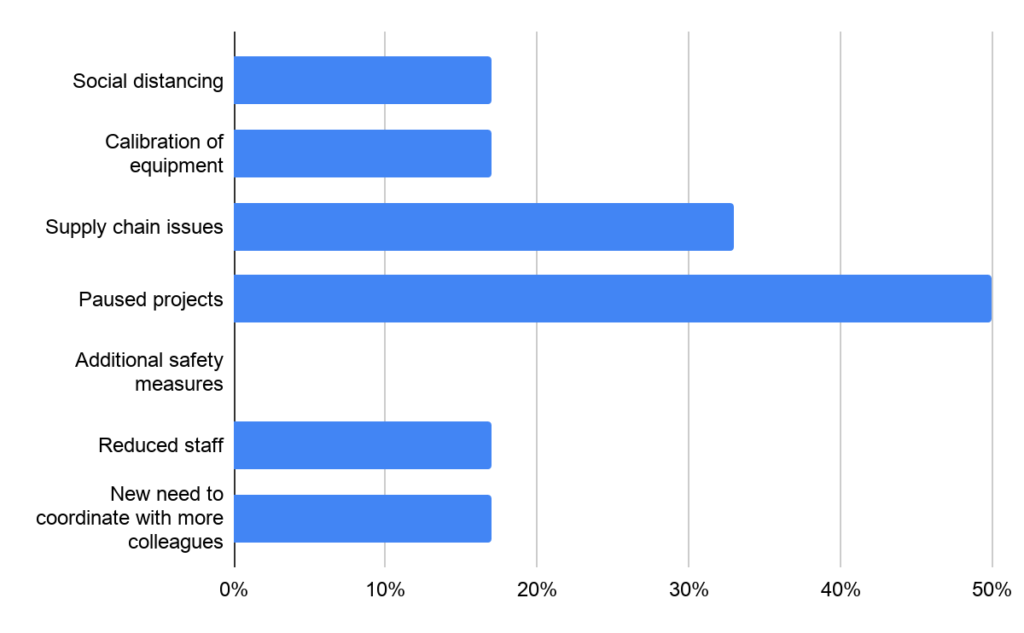As lockdown restrictions begin to ease across the globe and people return to work, lab scientists will also be returning to their projects and trying to get them back on track as soon as possible.
But what challenges or hurdles will scientists initially need to overcome on their return, and are there any surprises in store for those returning? Are there any obstacles to regaining productivity that scientists may not have considered?
At Synthace, our scientists are currently going through a phased return to the lab, with London-based team members working on site a few days per week if they can commute safely without using public transportation.
To find out more about their experiences and to glean useful insights that could help other scientists planning their return to the lab, we asked them some questions. All questions were answered anonymously, and some team members also volunteered to be interviewed.
I had this expectation that coming back to the lab was going to be business as usual. However... I realised it was going to take time to ramp up to the levels of productivity I had experienced prior to lockdown.
Scientists Are Excited To Get Back To Work, But Concerned About The Increased Risk of COVID-19 Infection
Initially, we wanted to get a feel for how happy our scientists were to return to the lab. All said they were ‘excited’ or ‘couldn’t wait’ to get back.
However, whilst we ensure every measure is taken on site to maintain a safe working environment, it is necessary for many of our staff to use public transport to get to the lab, which is based in West London.
As such, it was understandable that several lab members commented on concern about using public transport to travel to work. As scientist Alex Nash explains:
“I was excited to get back but also apprehensive about getting into the lab from home. Also, the inability to travel by normal routes has affected my flexibility in the hours I can work.”
With this feedback, we recognize the importance for team managers to think about every single team member and their personal needs when coming back to work, and to consider each case individually. We found this also helps with resource planning as the resources that we had before the COVID-19 crisis are no longer available.
‘Paused Projects’ Are The Biggest Issue To Returning Scientists, Not ‘PPE’ Or ‘Social Distancing’ In The Lab
With limited resources, it is important to identify essential project work and prioritize to minimize the impact of COVID-19 on productivity. However, this results in some projects being paused.
From the survey of our team, the biggest issue for returning scientists is the problem of paused projects. This issue was more frequently selected over social distancing and extra safety measures, as the graph below shows. As scientists Peter Kutapan explains:
“COVID-19 disruption is different from me taking a long holiday from the lab because no one has been there to help keep my projects ticking over or ensure equipment is maintained and calibrated.”

Synthace lab team responses to the question: ‘What are the major problems you have experienced when returning to the lab?’ (multiple selections were possible)
Advice For Scientists Planning a Return To The Lab
When asked if there is any advice our scientists would give other scientists prior to their return to the lab, these points arose:
- Account for some extra time for unexpected delays, especially in the beginning. Equipment might need extra calibration, reagents might have expired or have been moved, and there are fewer people around to help
- Work closely with Health and Safety teams to ensure the appropriate practicable processes are in place; everyone should be given access to their own personal protective equipment (PPE) and there should not be communal lab coats and safety goggles now
- If there are fewer team members, distributed maintenance tasks as part of lab management activities, such as autoclaving, cleaning devices, etc., may no longer be possible; therefore, a new rota may be useful, with the focus on essential functions and currently used equipment only
- Take the opportunity with few people around to get the lab back in shape - tidy up, purge old samples and reagents, organize resources; when all lab members are back, you will be in a better position to crack on with work
- There is likely a need to communicate and coordinate differently so think about new and key communication channels with interim team members for prioritized work and operations
- If doing a phased return, check in with colleagues to ensure resources and reagents are in stock and accessible; implementing or updating an inventory can make things easier
- Keep the non-disposable items of PPE apart and ensure they are labeled if they are to be reused
- Work as a team to ensure temperature-sensitive deliveries are received, fridges and freezers stay online and functional, and all lab areas are kept clean; be extra aware of temperature-sensitive deliveries as it is likely that lab management and logistics team members are less available
Do As Much Work As You Can From Home Prior To Returning
We asked our team what work they could do outside the lab. The scientists pointed out that they are lucky because they can plan experiments on the many liquid handling robots and other automation devices in silico thanks to our software platform’s cloud-based environment.
But for scientists that do not have the Synthace platform yet, now is a good time to work on:
- Writing documentation and focusing on coding
- Reporting and planning
- Reading
- Planning experiments, writing Standard Operating Procedures, sorting out lab management duties to improve performance on return
- Write-ups and upskilling via virtual training
If you would like to know more about the Synthace platform's capabilities and how it can help get your science back on track faster and improve your resilience to future disruption, sign up to our mailing list.


